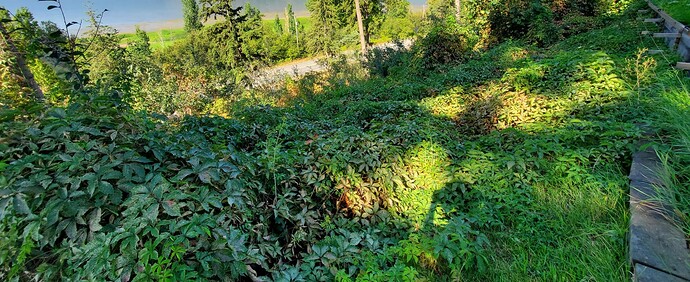I had to look up bitter sweet to find out what it is. LOL! We don’t have it down here in southern Tennessee and Alabama. They again, we don’t have gypsy moths either. Alas poor gypsy moth, fire ants got’em.
Wait, is that actually why we don’t have gypsy moths?
I had assumed we had higher rates of predation which kept them back, but had no idea it was the fire ants what did it!
You are lucky ones there!
It is a plague of North East!
We’ll take your bittersweet if you’ll take our kudzu ![]()
/me notes the deep meaning of someone trying to trade kudzu for bitter sweet vine. That is like trading a raging bull elephant for a placid rhino.
No update yet on the clean up. BUT… Here it comes the bridge!
Thanks to my always go to contractor - DH! The steps are foot wide and low enough to walk comfortably even loaded with tools or materials. All PT Ground contact, I hope it will last! It is my favorite spot in the yard now!
amazing how access can take a spot that was unappealing and turn it into your best place in a yard. enjoy!
An update: we are getting there! My husband decided to help me with trimmer. But as I suspected long vines make use of trimmer less efficient. You have to stop every minute and clean up the debris. But it is still faster than just manually pulling vines. we have probably 10-15% left untouched. So couple more days and then a pause for 4-6 weeks for new grows to appear, and spray after.
Looking forward to the next batch of pictures!
Stay safe, it’s bloody hot these days.
One suggestion is to not get in a big hurry to plant new ground.
So , if you are trying to eradicate aggressive weeds / vines this year, don’t assume they are going to be all gone , ready to plant next year.
I would continue cleanup into next year and see what you have. ?
Can be easier to be sure you have things under control in the second year , without valuable plants in the way. By the end of year two you should know if you have it under control.
Here is my plan: it all depends if the regrows will be successful in 4-6 week. If not, then I have to skip a year. In a mean time I will be using trimmer to have everything close to the ground and make sure next year by the end of August I have good grows to spay and kill the roots. If the grows will be good this year I will apply herbicide, may be multiple time, if I see new grows. Our fall is usually long, so I have time for 2-3 applications till leaves start changing color. After all dies off, I am going to mark future fence and install heavy duty landscaping fabric, covering 6’ wide outside perimeter, so it will give me a buffer. Then I mark future rows and 3X3’ spots for the bushes. Then I dig up the bush spots, removing most of the roots I found in each spot area. The rest I am going to cover with heavy duty landscaping fabric. I am going to order bushes in spring, but plant them in pots, so I can watch and spray their future home as needed. I can use cardboard on the open soil to prevent annuals. In late fall next year I will be able to put bushes in the ground.
Very thorough!
Curious if others have suggestions regarding the landscape fabric. I don’t have much experience, except with some cheap stuff that was both non-biodegrading and bad at stopping weeds–which in hindsight was a pretty poor combination.
I would suggest doing a soil sample. Pretty much all states have an extension office you can send soil samples to for tests, usually pH, soil properties, nutrients, and common contaminants are all tested. They send back the results and recommendations. And it is usually free, at least part of the year.
I have experience with heavy duty landscaping fabric. It has to be really heavy duty and thereof expensive, but it works very well between rows. The best one promised to work for 10 years. Not sure about that number, but I have pieces that I used for at least 6 summer seasons, still strong. Soil test will be done. But they are hardly free. $20-30 per sample depending on the test profile.
count yourself lucky. its quite a scourge. Its been starting to show up here in force in the last decade or two.
Sounds like a trade. Tell you what, Ill throw in some glossy buckthorn to sweeten the deal. And just so you don’t miss out, Ill send you a chunk of Japanese Knotweed rhizome the size of a junebug. Feel free to plant it in your nearest patch of slightly fissured asphalt. Your neighbors on the other side of the rd neednt be jealous, itll run right under the rd and come upon their side before long.
Perhaps the idea of kudzu growing here isnt that outlandish. Some years back I read that a massive patch of kudzu was discovered in (of all places) Ontario.
Yes, don’t buy “landscape fabric.”
Buy heavy duty woven “geotextile , driveway, soil stabilization fabric “ instead .
There are different grades ,some heavier than others.
It is normally used to put on roads / driveways, putting gravel on top, to keep the soil from mixing upward into the gravel.
Very tough stuff compared to common landscape fabric.
I have watched 30ton dump trucks drive over it on pumping wet red clay spreading gravel with no apparent damage.
Comes in 12ft and 17 ft wide rolls 100ft long here locally at the gravel yard.
Will usually sell by the ft. Off those big rolls .
Great under watermelons etc.
I use a small propane torch to melt holes in it to plant in.
Also use the torch to cut it, that way it melts the fibers together so it won’t unravel. Keeping a water spray bottle handy to put out fires .
Burry the edges, or good landscape fabric staples to hold edges down.
I use it in the garden, High tunnel, and under nursery stock.
Can also be used to Solarize soil , moved and then seed .
U.V. Stable , have some down going on 20yrs , still in great shape.
Most landscape fabric I have seen is junk by comparison.
I hooked a chain to a piece that had the edges buried for 10yrs and pulled it out undamaged with a farm tractor.
great tip. there are lots of grades of geotextile too, with even the baser grades being quite substantial
Crashing this thread again for advice on my particular vine covered land.
Vivaldi, you noticed one of the main problems. I think I need to keep this slope vegetated, maybe with larger shrubs or trees, to a). shade out the weeds, and b). stabilize the slope. Don’t want to cause a landslide that takes out part of the neighbor’s property!
Here’s the spot I want to deal with next. Absolute mess of Virginia creeper. It’s extremely well established and has roots basically everywhere on the ground surface.
If you squint your eyes at the third picture you may notice there is a bench about 15 feet below the top of the slope. That’s where I eventually want to put a row of raspberry and blueberry bushes. To stabilize the slope and crowd out the weeds I’d like to put in some kind of bushy shrubs or trees that I can chop and drop to keep pruned and not block the neighbor’s view. Although that might still be a ton of work to keep the nighshade from taking over; it seems to have no issues with shade. I’m also considering that a deep rooted grass might be the best choice.
Dang, this looks tough.
Normally, for a mess of vines without too many trees, backing up an elevated bush hog or, even better, using some kind of boom mower is the easier thing, but I don’t see how you’d get a tractor on that slope without killing yourself…
I am a bit out of my element in the mountains, but my feeling is, long term you either need grass with regular mowing, or a well closed canopy of trees, if you want to get rid of the vines. But, getting to that point is going to be… tricky. In either case, you will definitely need to spend a few years fighting off the vines while the competition gets established. But, again I’m not much good in the mountains, I don’t know how you’d actually do that without falling.
If the vines were not there, would you be able to safely walk up and down this slope, or is it too steep? Kinda looks like there are areas that are less steep, is that so, or is it a pretty straight gradient?
That is tough… I would start slowly from top and try to terrace it. This will make covering it with the plants easier. Make two terraces as one project. Use top one to plant and bottom one as a walking path. Cover it with heavy duty driveway fabric, for now you can keep it as is and later you can cover the path with some material of your choice on top of the fabric. To terrace you can use 12 inch wide pressure treated boards and some pipes to use as stakes(I hope it is not solid rock bellow the thin layer of soil) .
I’m happy with Creeping Red Fescue in my orchard area. Similar to what galinas faces, I can’t easily get a mower to there.
If CRF is mowed, it’ll basically look like any regular “yard”. If not it will still thrive and probably even better suppress “weeds”.




